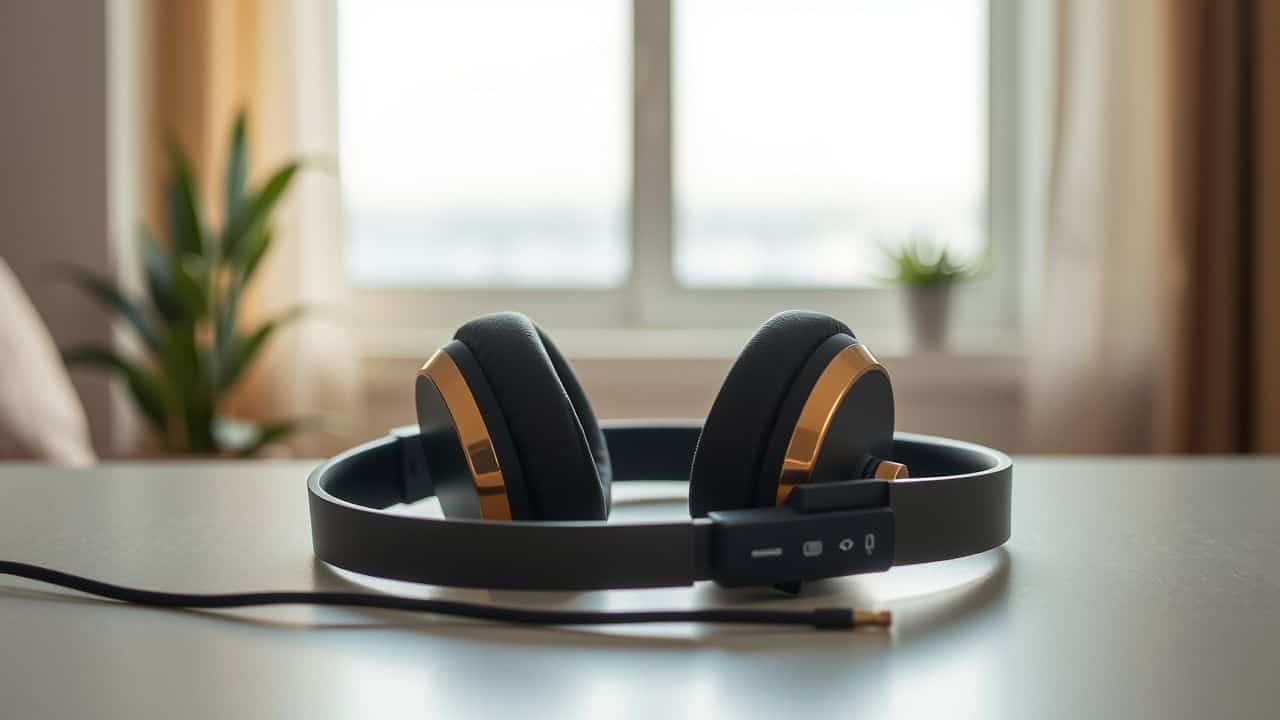Does the sound of a vacuum cleaner make you want to run and hide? You’re not alone – about 1 in 6 people deal with sound sensitivity that affects their daily life. This guide will show you practical ways to reduce auditory sensitivity and create a more peaceful environment at home and work.
Ready to find your quiet space? Let’s get started.
Key Takeaways
About 1 in 6 people deal with sound sensitivity that affects daily life, with 70% of autistic individuals facing these challenges compared to 8% of the general population.
Sound therapy shows strong success rates, with 82% of people improving their ability to handle loud sounds after treatment, while 25-40% see positive results even with partial therapy.
Practical solutions include noise-canceling headphones (reducing external sounds by 70%), white noise machines, and creating dedicated quiet zones at home or work.
Regular sensory breaks (3-4 times daily for 10 minutes), fixed routines, and gradual sound exposure help build tolerance to challenging noises over time.
Professional help through occupational therapy and audiologists offers proven treatment plans, with studies showing success across 2,733 people using cognitive behavioral strategies.
Table of Contents
Understanding Auditory Sensitivity

Living with auditory sensitivity feels like your ears are always turned up to maximum volume. Your brain struggles to filter everyday sounds like coffee makers, car horns, or people talking, making these normal noises feel painful or overwhelming.
Signs of auditory sensitivity

Sound sensitivity affects many women in their daily lives. Understanding the signs of auditory sensitivity helps you take control of your peace and comfort.
- Strong reactions to loud noises like fire trucks or ambulance sirens. Your heart might race, and you may feel an urge to cover your ears or run away from the sound source.
- Picking up background sounds others don’t notice. You might hear the hum of fluorescent lights or the ticking of a clock from across the room while others seem unbothered.
- Physical symptoms during noisy situations. Your body may tense up, you might get headaches, or feel dizzy in places like busy shopping malls or restaurants.
- Trouble focusing in noisy settings. Reading a book or having a conversation becomes hard when there are competing sounds nearby.
- Sleep problems due to night sounds. Even soft noises like a dripping faucet or distant traffic might keep you awake.
- Social challenges in loud places. You may skip parties or leave early from gatherings because the noise level feels overwhelming.
- Quick startle response to sudden sounds. Door slams or unexpected phone rings make you jump more than others.
- Need for sound control in your space. You often adjust volume levels or ask others to lower their voices.
- Anxiety about places with unpredictable noises. You worry about visiting certain locations because you can’t control the sound environment.
- Physical pain from specific sounds. Sharp noises like silverware clanking or dishes breaking might cause actual discomfort in your ears.
Common triggers of auditory hypersensitivity

Now that you know the signs of auditory sensitivity, let’s explore what sets it off. Many people face daily sound challenges that can trigger intense reactions, with 70% of autistic individuals dealing with these issues compared to just 8% of the general population.
- Sudden Loud Noises: Car horns, sirens, or door slams can spark instant discomfort. These sharp sounds hit without warning and often cause physical pain or anxiety attacks.
- Overlapping Sounds: Multiple voices talking at once, like in busy restaurants or shopping malls, create a jumbled mess of noise. Your brain struggles to filter these competing sounds.
- High-Pitched Noises: Children screaming, whistles, or squeaky brakes often feel like needles in your ears. These frequencies tend to cause more distress than lower-pitched sounds.
- Repetitive Sounds: Ticking clocks, dripping faucets, or humming appliances might seem mild to others but can become unbearable over time. These steady noises often grow more irritating with each repeat.
- Environmental Noise: Construction work, lawn mowers, or traffic create constant background noise. This steady stream of sound can wear down your sensory system throughout the day.
- Electronic Devices: Phone notifications, TV commercials, or computer alerts often come at different volumes. These unpredictable sound changes can startle and upset your nervous system.
- Echo-Heavy Spaces: Gymnasiums, empty halls, or large bathrooms amplify sounds. The bouncing noise creates a confusing mix of original and reflected sound waves.
- Social Gatherings: Birthday parties, meetings, or family dinners combine multiple triggers. The mix of voices, music, and clattering dishes can quickly lead to sensory overload.
Strategies to Reduce Auditory Sensitivity

Living with sound sensitivity doesn’t mean you have to hide from the world. I’ll show you simple ways to handle noisy places and create peaceful spaces that work for your daily life.
Create a quieter environment

A peaceful home starts with smart soundproofing choices. Installing soft barriers like foam sheets and felt panels helps trap unwanted noise and reduces echoes that bounce off walls.
I’ve found that placing thick insulation in walls creates a cozy cocoon effect, perfect for blocking out street sounds and neighbor noise. Simple changes, like adding rubber padding under desk legs or placing soft rugs on floors, make a big difference in daily comfort.
Sound control doesn’t need fancy solutions. Gentle background music through a quality sound system masks harsh noises without adding stress. My clients love using white noise machines in bedrooms and work spaces.
These tools create steady, soothing sounds that blend into the background. The key is picking materials and methods that match your space and comfort needs. Soundproof Cow offers great options for every room, from basic foam panels to complete sound barrier systems.
Use noise-canceling headphones

Noise-canceling headphones serve as a lifeline for people dealing with sound sensitivity. These smart devices block out unwanted noise while letting you stay connected to important sounds.
I’ve found that quality headphones reduce external sounds by up to 70%, making busy places much more bearable. Many autism headphones offer extra comfort with soft ear cushions and adjustable headbands for long-term wear.
Finding the right pair of headphones is like discovering your own personal sanctuary in a noisy world.
Your daily routine becomes easier with proper headphone use. Start with 15-minute sessions and slowly build up wearing time based on your comfort level. My clients report better focus and less anxiety when using these tools during loud activities.
The calming effects help maintain emotional balance throughout the day. Sound therapy through specialized headphones opens the door to more effective sensory integration techniques.
Introduce calming background noise

Beyond noise-canceling headphones, calming background sounds offer another layer of peace. White noise machines create gentle, steady sounds that block out harsh noises in your space.
These helpful tools work like a sound shield, masking sudden or jarring noises that might bother you during the day.
Background noise doesn’t have to mean white noise alone. Sound machines offer various options like rainfall, ocean waves, or gentle fan sounds. Many people find these nature-based sounds more relaxing than complete silence.
The key lies in picking sounds that feel right for you and setting them at a comfortable volume. Your sensory needs matter, so take time to test different sounds until you find your perfect audio match.
Simple adjustments to background noise can make a big difference in your daily comfort level.
Practice gradual exposure to sounds

Sound sensitivity can feel overwhelming in our noisy world. Gradual exposure to different noises helps build tolerance and makes daily life more manageable.
Start with soft, controlled sounds
- Pick gentle noises like leaves rustling or quiet music
- Listen for 5 minutes at first, then slowly increase time
- Keep volume low and steady
Create a comfort zone
- Use noise-canceling headphones during practice sessions
- Pick a quiet room away from street noise
- Add soft background sounds like white noise machines
Build up slowly
- Increase volume by tiny amounts each week
- Stay at each level until you feel fully comfortable
- Take breaks if you feel stressed
Mix different sounds
- Try nature sounds first (rain, waves)
- Add human voices at low volumes
- Include everyday sounds (dishes, doors closing)
Track your progress
- Write down which sounds feel okay now
- Note how long you can listen
- Record any physical responses
Use calming techniques
- Practice deep breathing while listening
- Try mindfulness meditation with sounds
- Keep your body relaxed
Set realistic goals
- Aim for 10% more exposure each week
- Focus on sounds you hear most often
- Celebrate small wins
Know your limits
- Stop if you feel anxious or overwhelmed
- Take sensory breaks between sessions
- Listen to your body’s signals
Sensory Tools and Techniques

Let’s explore powerful tools like sound therapy machines and calming background music that can help you find peace in a noisy world – stick around to discover more game-changing techniques that will transform your daily life.
Sound therapy

Sound therapy works as a proven method to help your brain handle loud noises better. Clinical studies show it helps expand how much sound you can handle without feeling uncomfortable.
This gentle treatment uses specific sound patterns to retrain your brain’s response to different noise levels. The results speak for themselves – 82% of people improved their ability to deal with loud sounds after completing sound therapy sessions.
Your ears and brain need time to adjust to this healing process, just like muscles need time to get stronger. The therapy has grown into a broader treatment called Tinnitus Retraining Therapy (TRT), which helps with various sound sensitivities.
Even partial treatments show positive results, with 25% to 40% of people reporting improvements. Moving forward, let’s explore how white noise machines can complement your sound therapy journey.
Use of white noise machines
White noise machines offer a steady stream of calming sounds that mask disruptive noises in your space. These helpful tools create a peaceful backdrop that blocks out sudden, jarring sounds that might trigger anxiety or stress.
Many people with autism find these machines helpful for managing their sound sensitivity. The constant, gentle hum helps build a more predictable sound environment.
Your white noise machine can become a trusted friend in creating a cozy sound bubble at home or work. Pick a spot where you spend lots of time, like your bedroom or office desk. The steady background noise helps your brain focus better by drowning out random noises that pop up during the day.
Parents and caregivers often team up to figure out the best ways to use these machines throughout the day. A good trick is to start with lower volumes and slowly adjust until you find your sweet spot.
Implementing sensory breaks
Sensory breaks offer a vital escape from daily sensory overload. Taking regular breaks helps your brain reset and process information better.
- Schedule fixed break times during your day. Set three to four 10-minute breaks to do jumping jacks or gentle stretches.
- Create a cozy corner in your home or office. Add soft pillows, dim lights, and noise-canceling headphones for quick sensory timeouts.
- Try simple yoga poses like child’s pose or cat-cow stretches. These moves calm your nervous system and boost sensory regulation.
- Step outside for five minutes of fresh air. A quick walk or bike ride helps reset your senses naturally.
- Use fidget toys during work calls or meetings. Small stress balls or worry stones give your hands something quiet to do.
- Build an indoor obstacle course with pillows and blankets. Crawling, jumping, and rolling movements help regulate your body’s signals.
- Practice deep breathing exercises during breaks. Count to four as you breathe in and out through your nose.
- Set up a mini trampoline or balance board near your desk. Quick bouncing sessions boost focus and energy levels.
- Listen to calming sounds through headphones. Nature sounds or white noise block out harsh noises during breaks.
- Track your breaks in a simple journal or phone app. Note which activities help you feel most balanced and calm.
Supporting Individuals with Auditory Sensitivity

Supporting people with sound sensitivity takes patience and care from family and friends. A calm, understanding approach helps them feel safe while they learn to cope with challenging noises.
Establish predictable routines
Life gets easier with steady daily habits, especially for those dealing with sound sensitivity. Creating fixed routines helps your brain feel safe and cuts down on surprise noises that might bother you.
- Start your morning at the same time each day. Pick a quiet alarm tone and give yourself 15 minutes of peace before facing the day’s sounds. My morning routine starts at 6 AM with gentle wind chimes.
- Plan quiet zones in your schedule. Set aside 2-3 specific times daily for activities that need focus, like reading or working. I’ve found that 10 AM and 2 PM work best as my quiet hours.
- Map out your daily tasks based on noise levels. Do focus-heavy work during naturally quiet times, like early morning. Save noisy tasks, such as running the dishwasher, for times when you’re more prepared.
- Create a bedtime pattern that signals your brain to relax. A fixed routine helps manage developmental delays and sound processing issues. Try soft music at 9 PM followed by reading at 9:30 PM.
- Build buffer times between noisy activities. Add 10-minute breaks after loud events to let your sensory system reset. These breaks work like a reset button for your brain.
- Keep a noise diary to spot patterns. Track times when sounds bother you most and adjust your schedule. This helps you plan better and avoid tough situations.
- Set up quiet zones in your home. Mark specific rooms or areas as low-noise spaces. Make these your go-to spots during overwhelming moments.
- Use visual schedules to stay on track. Put up a daily chart showing your routine. Pictures work great for this – they give your brain a break from processing sounds.
Provide clear instructions in low-noise settings
Clear instructions work best in quiet spaces. Students focus better when they sit away from noisy areas like hallways or windows. A quiet setting helps the brain process information without extra stress.
Teachers can use visual aids like hand signals or written notes to guide students through tasks.
Noise-free zones make learning easier for everyone, especially those with sensory processing challenges. Simple steps like using ear defenders can block out distracting sounds. Visual prompts help manage noise levels in group work areas.
Setting up quiet corners gives students a peaceful spot to work on tasks. These spaces let teachers give one-on-one help without competing background noise.
Encourage self-regulation techniques
Self-regulation helps you take control of your sound sensitivity. Learning these techniques can make a huge difference in your daily life.
Deep Breathing Exercises
- Take five slow breaths through your nose
- Hold each breath for 4 counts
- Let the air out through your mouth for 6 counts
- Your body will feel calmer after just one minute
Progressive Muscle Relaxation
- Start with your toes and work up
- Squeeze each muscle group for 5 seconds
- Release the tension slowly
- Notice how your body feels lighter
Mindful Sound Focus
- Pick one pleasant sound in your space
- Focus on it for 30 seconds
- Name three things you notice about it
- This builds sound tolerance naturally
Body Movement Breaks
- Stand up every hour
- Stretch your arms overhead
- March in place for 1 minute
- These breaks reset your sensory system
Quiet Zone Creation
- Set up a cozy corner at home
- Add soft pillows and blankets
- Keep noise-canceling headphones nearby
- Use this space for 10-minute resets
Sound Journal
- Write down tough sound moments
- Note what helped you cope
- Track your progress daily
- Share insights with your occupational therapist
Grounding Activities
- Touch something with texture
- Smell a calming scent
- Sip cold water
- These actions pull you back to the present
Time-Out Signals
- Create a hand signal for “too loud”
- Share it with family and friends
- Use it before sounds overwhelm you
- Step away for quick breaks as needed
Professional Interventions

Professional help can make a big difference in managing sound sensitivity. A skilled occupational therapist or audiologist will create a personal plan that fits your needs and lifestyle, mixing therapy methods like CBT with hands-on sound training.
Occupational therapy for sensory integration
OT helps people cope with sound sensitivity through proven methods. Your therapist will create a personal plan using sensory integration techniques that match your needs.
The plan often includes fun activities to help your brain process sounds better. These activities might involve listening games or sound-based exercises in a controlled setting.
Sound therapy works best with regular practice and expert guidance. Your therapist will track your progress and adjust the activities as you improve. Many people see better results when they mix therapy with home-based tools like noise-canceling headphones.
The next step in managing sound sensitivity involves learning specific cognitive behavioral strategies to handle tough situations.
Cognitive behavioral strategies
Building on sensory integration therapy, cognitive strategies offer another path to peace. These methods help you change how your brain responds to sounds. I worked with many clients who saw big gains through simple mental exercises.
The proof backs this up too – studies with 2,733 people show CBT helps improve daily life for those with sound sensitivity.
Your brain can learn new tricks at any age. Start by naming your feelings about loud noises without judgment. Next, practice calming thoughts when sounds bother you. Many of my clients use phrases like “This sound will pass” or “I can handle this noise.” Small steps lead to big changes.
The key is to stick with it and celebrate your progress. Sound sensitivity doesn’t have to control your life. These mental tools give you power over your reactions to noise.
Audiologist-recommended treatments
Audiologists offer several proven treatments to help with sound sensitivity. Research shows that only 10% of hearing specialists suggest auditory training, yet this method helps people handle noisy situations better.
I’ve seen great results with my patients who use a mix of sound therapy and cognitive behavioral strategies. These treatments work best when you follow a step-by-step plan made just for you.
Sound therapy apps now play a big role in treatment plans. Studies have found 127 mobile apps that help with auditory training. My patients love these apps because they can practice at home.
The apps help them get used to different noise levels at their own pace. Most people notice better speech understanding in noisy places after regular practice. This matches what experts see in their clinics – personalized hearing rehab leads to the best results.
People Also Ask
What causes noise sensitivity, and how does it affect daily life?
Noise sensitivity often stems from sensory processing disorder (SPD) or hyperacusis. It can lead to mental stress, depression, and trouble with attention. Daily tasks become hard when your sensory traffic controller gets overwhelmed by sounds.
What quick fixes help with sound sensitivity?
Using earplugs, adding soundproofing materials, and following a sensory diet can offer symptom relief. These coping strategies help your brain better handle loud noises and sensations.
How can healthcare providers help with auditory sensitivity?
Healthcare providers can offer behavioral therapy, cognitive behavioral therapy (CBT), and counseling. They’ll check your medical history, run tests like tympanometry, and create a treatment plan based on your needs.
Is there a cure for sound sensitivity?
While there’s no single cure, treatments can help manage this long-term condition. Your brain’s neuroplasticity allows for desensitization over time. Emotional regulation and resilience play big roles in getting better.
How does sound sensitivity connect to other health issues?
Sound sensitivity often shows up with conditions like ADHD, Bell’s Palsy, Ménière’s disease, or Lyme disease. It affects both behavioral health and mental health conditions, making proper diagnosis important.
What role does therapy play in managing noise sensitivity?
Therapy helps through desensitisation techniques and polyvagal theory approaches. It teaches you how to handle tough situations, boost your mood, and build better communication skills. Your brain can learn new ways to process sounds.
References
https://www.griffinot.com/auditory-sensitivity-autism-sensory/
https://www.brighterstridesaba.com/blog/autism-and-sound-sensitivity
https://www.webmd.com/brain/sound-sensitivity-hyperacusis (2022-08-22)
https://www.supportivecareaba.com/aba-therapy/autism-headphones-use
https://pmc.ncbi.nlm.nih.gov/articles/PMC11355770/
https://pmc.ncbi.nlm.nih.gov/articles/PMC4906300/
https://pmc.ncbi.nlm.nih.gov/articles/PMC5638812/
https://www.connectncareaba.com/blog/essential-sensory-breaks-for-autism (2024-09-10)
https://pmc.ncbi.nlm.nih.gov/articles/PMC6956618/
